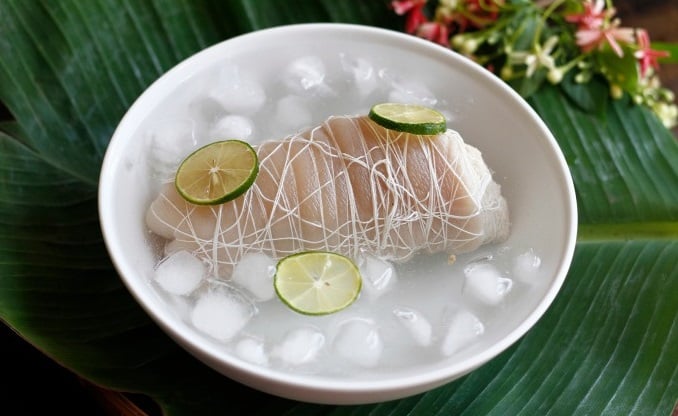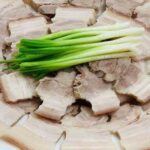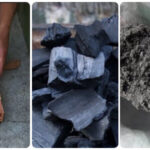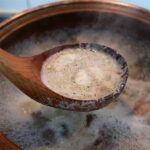1. Selecting and Preparing Pork Hock
Choosing fresh and good-quality pork is essential for a delicious boiled pork hock dish. Fresh pork hock usually has a natural light pink color, a dry surface, and is slightly bouncy when pressed. Avoid buying pork with dark spots, a sticky texture, or an unusual odor, as these are signs of low-quality meat. According to folk wisdom, “Eat the hind legs and give the front legs to each other,” so choose the hind legs for firmer and crispier meat, while the front legs are more suitable for ‘giả cầy’ (a traditional Vietnamese pork dish).
Once you’ve selected the meat, remove the bones, rinse thoroughly, and pat dry. Roll the meat lengthwise within the skin and use specialized kitchen twine or bamboo strips to tie it into a cylindrical shape. Note not to tie it too tightly, as the meat will expand during boiling and may crack if tied too tightly.

Selecting fresh and good-quality pork is key to a tasty dish.
2. Boiling the Meat Properly
Before boiling, blanch the pork hock to remove impurities and rinse it again. If you prefer sweeter meat, boil it in boiling water from the start. If you need to use the broth for soup, place the pork in cold water and then bring it to a boil. Ensure you have enough water to cover the meat so that the skin turns white. Add a few crushed shallots, some crushed ginger, and peppercorns to infuse flavor. Season with a pinch of salt and seasoning powder to enhance the meat’s sweetness. If you wish to eliminate any unwanted odors, add a splash of rice wine to the boiling water.
Once the water boils, reduce the heat to low and let the pork hock cook evenly from the outside in. Occasionally skim off any foam that rises to the surface. The boiling time depends on the size of the pork hock, typically ranging from 15 to 20 minutes. Afterward, turn off the heat and let the meat soak for another 8 to 10 minutes. This step ensures that the meat absorbs the broth, becoming juicier and avoiding a reddish appearance inside. Use a bamboo skewer to poke the meat; if no pink juices come out, it’s cooked.
3. Shocking for Crispy, White Skin
Once the pork hock is cooked, immediately immerse it in a clean ice bath to shock the meat, helping the skin tighten and become crispier. Add a splash of lemon juice to the ice bath to enhance the whiteness and fragrance of the meat.
4. Achieving a Sticky Texture
Wait for the pork hock to cool down, then pat it dry with a clean towel. Place it in an airtight container and refrigerate it for at least a few hours to let the meat set and firm up, making it easier to slice thinly. At Hanoi’s famous ‘bún đậu mắm tôm’ (Vietnamese vermicelli with fried tofu and shrimp paste) eateries, the pork hock is typically boiled in advance and stored in the fridge overnight before being sliced thinly for serving.

Wait for the pork to cool down, then pat it dry.
When slicing the meat, remove the twine, wear gloves, and use a sharp knife to cut thin slices. Arrange the slices on a plate or platter.
Desired Outcome: The pork hock slices should be firm, crispy, and fragrant, with a natural sweet and tender taste. Depending on regional preferences, various dipping sauces can be paired with the dish, such as lime pepper salt, fish sauce with chili and garlic, pickled onion fish sauce, whipped shrimp paste, fermented shrimp paste, Hue-style sour shrimp paste, or ‘mắm nêm’ (a type of anchovy sauce) from Danang. This dish is especially refreshing during the summer months when served with cool vermicelli noodles and fresh herbs.
“The Ultimate Guide to Perfectly Boiled Meat: Retaining Moisture, Even Cooking, and Maximizing Nutrition”
Here’s a mouth-watering introduction to a delicious pork dish that will tantalize your taste buds and impress your guests.
Discover the ultimate method for cooking tender, juicy, and flavorful pork that will leave your taste buds dancing. Uncover the secrets to creating a mouth-watering masterpiece that will have your guests asking for more. Learn how to prepare pork to perfection, ensuring every bite is a burst of flavor. This guide will reveal the tricks to transform your ordinary meal into an extraordinary culinary experience. Get ready to indulge in the ultimate pork feast!
“The Quick-Fire Coal Hack: Get Your Coals Blazing in No Time”
Sure, I can assist you with that.
“Tired of slow-burning coals or quick-flaring flames ruining your BBQ fun? Fear not, as we’ve got a pro tip to get your charcoal burning efficiently and consistently. Imagine being the BBQ hero, with sizzling skewers and perfectly grilled goodies, all thanks to your newfound charcoal-burning secrets!”



































